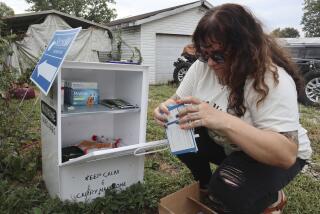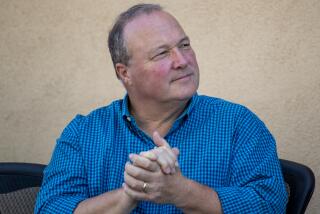Q&A: Sam Quinones outlines the path of addiction from painkiller to heroin
- Share via
“It’s a great day to be a heroin dealer in America,” says Sam Quinones, the author of “Dreamland: The True Tale of America’s Opiate Epidemic (Bloomsbury: 384 pp., $28), a brisk and startling new book on painkiller and heroin addiction in the United States.
More than half a million Americans a year now use heroin, and many of those users’ addictions began with pills like Oxycontin. “Dreamland” is the story of how the nation’s addiction epidemic was nurtured into crisis by pharmaceutical salespeople and doctors who billed Oxycontin as a risk-free wonder drug and by an enterprising network of traffickers from a small village in Mexico who delivered black-tar heroin on demand to desperate pill addicts in midsized cities and suburbs across the U.S.
Although Quinones’ story hops around the country, the path of addiction is always easy to trace. “Wherever those pills go,” says Quinones, a former Los Angeles Times reporter, “heroin comes.”
FULL COVERAGE: FESTIVAL OF BOOKS
Explain how a single paragraph of medical literature propelled the Oxycontin epidemic.
This letter was forgotten by the guy who wrote it [Dr. Hershel Jick, in a 101-word letter to the editor of the New England Journal of Medicine].... The letter said he checked his [medical] database and found 11,000-plus patients who were given narcotic painkillers in the hospital; only four got addicted. He wrote that in a letter, sent it in, they published it in 1980, and he quickly forgot it.
That was later picked up by the pain specialists who wanted to break down this phobia [of addiction] with regard to pain treatment by opioids, and they ran with it.... Nobody bothered to read it.... First it was called a report, then it was called a study, then it was called a landmark report, and then finally a landmark study, and in none of these cases was that a correct description.... I kept thinking, “This can’t be possible, this is not true, how can one little letter that is nothing, a toss-off, have changed so many minds?”
INTERACTIVE GAME: HOW TO BE A WRITER
What role do Levi’s 501 jeans play in this whole saga?
What got me into this story was working on a piece for the L.A. Times about an entire town in Mexico where everyone sells heroin retail in the United States and sells it like pizza. This system gathered recruits for a lot of reasons, but one of the weirdest ones was that people realized early on [that] they could trade dope for Levi’s 501s [which were, in the 1990s, the gold standard of rural menswear] and they would come back to the village with 50, a hundred pairs of the jeans, hand them out as if they were Santa Claus....
You talk about how Oxycontin had become its own currency in the United States. What is the strangest thing that you discovered had been bought with pills?
T-bone steaks, cable service, kidnap ransom. In some areas — in particular in the town that I focused on, Portsmouth, Ohio — there was so many pills in those areas, the pills mills [where doctors prescribed pills wantonly] were like the central banks. They controlled the currency, which were pills. Once you’re addicted, you don’t care about money. All you care about is dope. ... People would rob dealers and not take their money, they would take their pills....
Do you think the opiate epidemic is here to stay or is there a vanishing point in sight?
The demand is being primed not by the underground mafia, not by the underworld gang, but by the legitimate doctor, overprescribing for all kinds of things that probably don’t need it. I had my appendix out about six years ago. They gave me 60 Vicodin. They never explained to me what Vicodin was. They never explained to me why I needed 60. ... It’s a very scary fact that we have [problems] in states like Alabama and Idaho and Tennessee, places you don’t think of opiate addiction being a problem. Because wherever those pills go, heroin comes. ... There were no heroin addicts to speak of in Alabama or Idaho, and now there are.
Do you see any symmetries between the pharmaceutical companies and the Mexican heroin dealers in terms of business practices?
Without a doubt. I conceived of this book as twin tales of drug marketing. Obviously one is a legitimate drug and one is an illegal drug.
I think the reliance on personal service as a marketing tool — a customer service of going to the doctor to give him a brochure about your drug and making that personal connection — the Xalisco Boys from Nayarit have the same way of doing [business]. They develop personal relationships with the junkies; if there’s any sign they’re going to quit they give them free dope. They’re always trying to be very customer-service oriented, get there quickly as much as they can. ... It’s all a part of you having to avoid any discomfort in your pain and in finding the drug.
All this is part of who we’ve become as a country.
Quinones will appear at the Festival of Books on April 19.
More to Read
Sign up for our Book Club newsletter
Get the latest news, events and more from the Los Angeles Times Book Club, and help us get L.A. reading and talking.
You may occasionally receive promotional content from the Los Angeles Times.









